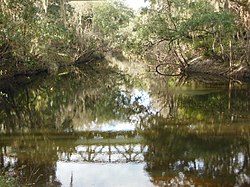2000 census
At the time of the 2000 US Census, [3] there were 1,991 people, 678 households, and 581 families residing in the community. The population density was 121.8 inhabitants per square mile (47.0/km2). There were 798 housing units at an average density of 48.8 per square mile (18.8/km2). The racial makeup of the community was 91.41% White, 4.12% Black, 0.15% Native American, 0.80% Asian, 2.06% from other races, and 1.46% from two or more races. Hispanic or Latino of any race were 6.08% of the population.
There were 678 households, out of which 43.4% had children under the age of 18 living with them, 76.0% were married couples living together, 6.9% had a female householder with no husband present, and 14.3% were non-families. 10.6% of all households were made up of individuals, and 2.7% had someone living alone who was 65 years of age or older. The average household size was 2.94 and the average family size was 3.16.
In the community, the population was spread out, with 29.6% under the age of 18, 5.6% from 18 to 24, 35.7% from 25 to 44, 23.1% from 45 to 64, and 6.0% who were 65 years of age or older. The median age was 35 years. For every 100 females, there were 98.5 males. For every 100 females age 18 and over, there were 96.4 males.
The median income for a household in the community was $65,857, and the median income for a family was $67,286. Males had a median income of $42,321 versus $35,662 for females. The per capita income for the community was $26,540. About 2.0% of families and 3.3% of the population were below the poverty line, including 3.6% of those under age 18 and none of those age 65 or over.
2020 census
As of the 2020 census, there were 24,625 people, 7,745 housing units, and 7,419 families in the CDP. The population density was 1,518.7 inhabitants per square mile. The racial makeup was 77.8% White (17,600 people), 8.4% African American (1,142), 0.1% Native American (52), 5.0% Asian (1,562), 0.0% Pacific Islander (12), and 6.8% from two or more races (3,438). Those of Hispanic or Latino origin made up 16.1% (3,872 people). [11] [12]
The ancestry of Fish Hawk was 10.8% German, 8.5% English, 7.6% Irish, 6.7% Italian, 2.5% Polish, 2.5% Scottish, 2.2% French, 2.0% Norwegian, and 0.3% Sub-saharan African. [12]
The median age was 33.6 years old. A total of 7.5% of the population were 65 or older, with 5.0% between the ages of 65 and 74, 2.2% between the ages of 75 and 84, and 0.4% 85 or older. A total of 35.7% of the population were under 18, and 8.1% were under 5. The gender makeup was 52.3% female and 47.7% male. [11] [12]
The median household income was $119,946, with families having $127,659, married couples having $142,572, and non-families having $65,000. A total of 8.7% of the population were in poverty, with 9.9% of people under 18, 8.7% of people between the ages of 18 and 64, and 3.1% of people 65 or older were in poverty. The per capita income was $44,431. [11] [12]
The area was transformed by development throughout the following decade, with the population growing over 700%, from under 2,000 to 14,087 in the 2010 US census, while the median household income also increased dramatically from $65,857 to $107,250. [13] To accommodate the rapid growth, the Hillsborough County School District opened several new schools in the area, including Newsome High School in 2003.



